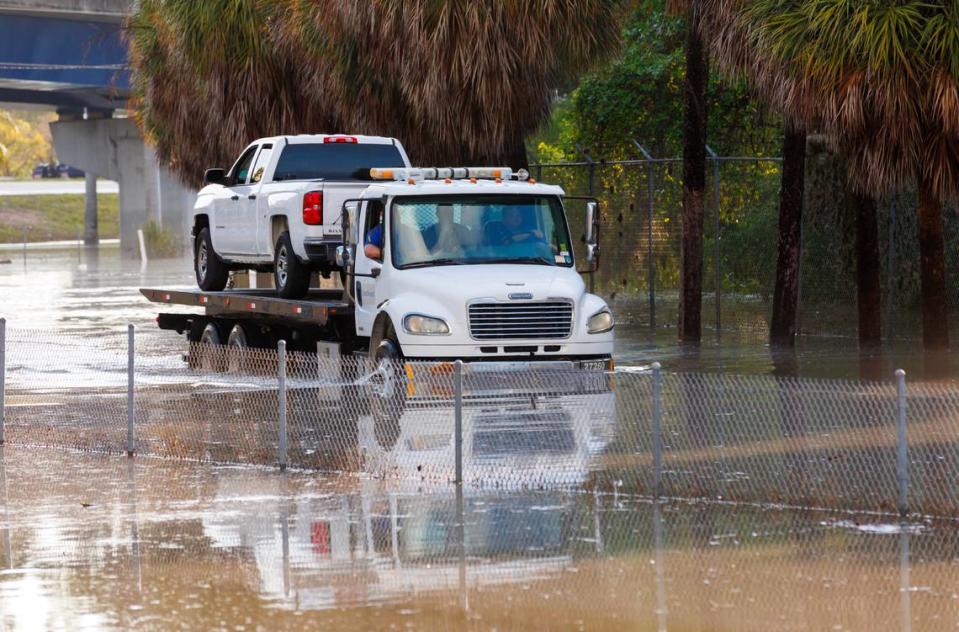Cars went underwater in the South Florida flood. What to know about what’s next
Cars and flooded streets — they just don’t go together.
That’s why so many cars stalled, floated away or sank into the deep water in South Florida late Wednesday.
Broward County was hit hardest, particularly dowtown Fort Lauderdale and the airport area near Dania Beach. But downtown Miami felt the flooding rains on Monday night.
It doesn’t take much water to mess up a car.
While the most obvious advice is to not drive through deep floods, people want to get to their destinations and go right into the asphalt swamp. But even parked cars can suffer from water damage when the rising flood hits the undercarriage or seeps through the doorways.
What can go wrong if you drive through deep water? A few things to know, from the Miami Herald archives:
How water can damage vehicles
▪ Driving through deep puddles could flood the engine. Parked cars also are at risk.
▪ If a car is parked at an angle with the deepest water near the front seats, where cars’ computer systems are often located, the electronics in the car may be damaged.
▪ Tow your soggy car to get it checked out. That way, mechanics can determine the severity of water damage and whether the engine can be dried out or needs replacement.
▪ Mechanics advise that car owners rinse their cars after floods — especially near Miami Beach, where floodwater can mix with saltwater from the ocean. Once that happens, salt can deteriorate the paint on top and car parts underneath.
▪ Call your insurance company if water rises to the seat-belt area.
▪ For less obvious water damage, car owners might eventually smell mold or mildew.
▪ If you made it through a deep puddle and the “check-engine” light briefly turned on, have the car checked.
▪ The best prevention? Avoid the flood.

How to identify a flood-damaged car
Vehicles that suffer flood damage may have mechanical, electrical and safety problems because the anti-lock brake system may not work properly. Damaged airbags also may fail to deploy in case of accidents.
Humidity and bacteria inside the car may also generate respiratory and other health issues for drivers and passengers.
And water-damaged vehicles can get on the market for resale.
Carfax offers the following recommendations for detecting water-damaged vehicles:
▪ Close the car windows to check for a musty odor that might be caused by dampness.
▪ Be wary of cars that smell “too nice.” A scent may be used to mask musty odors.
▪ Look for water stains or replaced sections in the upholstery and rugs. Better yet, lift the rugs and look.
▪ Check the trunk and glove compartment for signs of flooding.
▪ Watch for signs of corrosion on metal parts.
▪ Look under the hood for leaves or debris in suspicious places.
▪ Check the oil. A single drop of water in it is a sign of serious mechanical problems.
▪ Check the air filter for signs that the paper was wet at some point.
▪ Cloudy headlights or instrument gauges can be signs that the vehicle was under water.
▪ When you test drive the car, keep an eye on the electrical system, which can be damaged in a flood.
▪ Take your car to a mechanic for an opinion. He or she can perform a more detailed inspection for repairs designed to hide water damage.
▪ Use a car dealership that is well established in your community. Reputable dealers will not risk their reputation by selling water-damaged vehicles.
▪ Check the vehicle’s history in Internet pages such as AutoCheck, CARFAX Vehicle History Report or VehicleHistory.com.
▪ Be direct. Ask if the vehicle suffered water damage, and ask the seller to put the answer in writing.
▪ Read the vehicle’s title carefully. If the words “flood” or “salvage” show up, don’t buy it.

